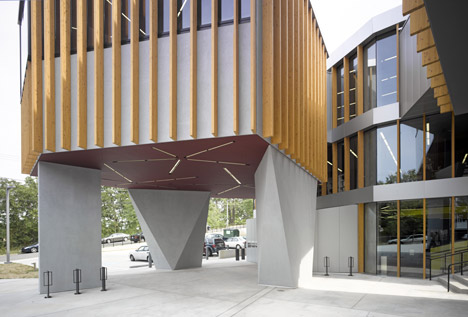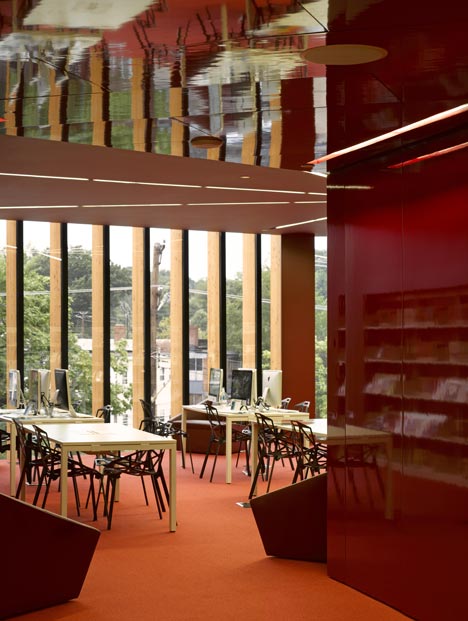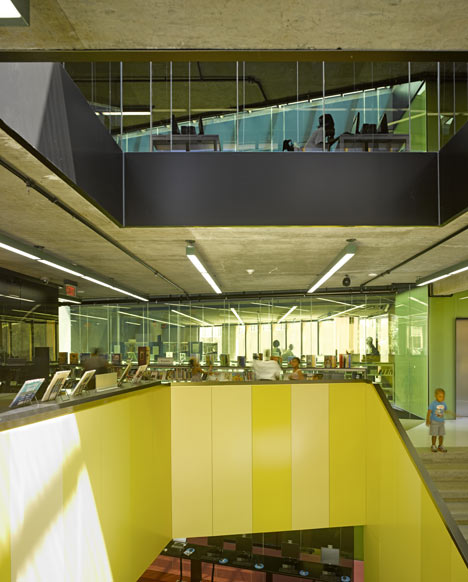The William O. Lockridge/Bellevue Library by Adjaye Associates
The second of two new libraries in Washington DC by architects Adjaye Associates comprises grey concrete blocks with yellow timber fins.

The William O. Lockridge/Bellevue Library is located in a residential neighbourhood in the south of city and sits on a gently sloping site.

The central volume of the building contains reading areas for adults, children and teenagers, while group study areas and conference rooms are located in the three wings that adjoin. Faceted concrete legs raise these wings above the ground, creating a sheltered amphitheatre and bicycle parking area by the entrance.

Read about the first of the two libraries here, or click here to see Adjaye's recent designs for a bitumen-coated pavilion at the Tate Liverpool gallery.
See all our stories about David Adjaye »
See more libraries on Dezeen »
Photography is by Edmund Sumner.
Here's some more text from Adjaye Associates:
Adjaye Associates’ Community Libraries in Washington DC open to the public
Adjaye Associates’ new neighbourhood libraries for the District of Columbia, the William O. Lockridge/ Bellevue Library and Francis Gregory Library, have opened to the public. The brief called for the new buildings to be “flexible, accessible, welcoming and inviting” and the libraries challenge the traditional closed typology, introducing a social element with a strong urban and cultural programme.
The William O. Lockridge/Bellevue Library
“Communities need empowering buildings – and this neighbourhood library is all about the creation of a strong beacon for its community. The primary act of public architecture is to create spaces that are socially edifying and socially liberating – using design excellence as a social force that makes good. This is at the heart of my work, so it is very exciting to see this building welcome its community through its doors.” - David Adjaye
The William O. Lockridge/Bellevue Library is characterized by its celebration of views across the neighbourhood, and the insertion into the dramatically sloping site topography. The challenge was also to create a civic building within a residential context. Rather than a single monolithic form, the library is a cluster of geometric volumes, both elevated and grounded physically to the site.
Using the grounded main volume to host the library central stacks and primary reading, the elevated volumes create a welcoming portico at the entrance that can be used for events and informal gatherings. The volumes mediate the scale of the building by using small, medium and large forms, derived from the library’s program but also capturing the surrounding urban fabric and the site topography, while resonating with neighboring residences of a similar composition. Wrapped in a concrete and glazed skin replete with timber fins, the envelope not only resolves structural and shading requirements, but also articulates the vertical presence of the building juxtaposed to the sloping landscape.
By fragmenting the building into smaller volumes, the arrangement takes advantage of the natural topography by setting the library to maximize the eastern exposure for filtered natural lighting, which is the primary light source. On plan, the volumes follow the geometry of the site to form a series of identical, shifting rectangles.
The library service areas are layered, with adults, teenage and children’s services contained within the separate volumes. The first floor contains the circulation desk, adult browsing, sights and sound, a meeting room and library staff support spaces. The second floor has additional adult browsing and children services. The third floor contains further adult, meeting rooms and teen services. The concrete staircase, taking visitors up to the higher levels, matches the incline of the street to suggest a sense of bringing the street – and the neighbourhood – inside.